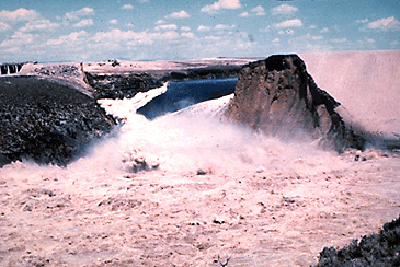FALL 2014
FINAL EXAM
MONDAY, DECEMBER 15, 2014, 1530-1730
Name: ____________________ Red ID _______________ Grade: _______
Instructions: Closed book, closed notes. Use engineering paper. When you are finished, staple your work in sequence (1 to 4), and return this sheet with your work.
- (20%) A hydraulically wide channel is operating at Froude number F = 0.2.
The unit-width discharge is q = 3 m2s-1.
What are two Langrange absolute celerities?
- (20%) You are observing the rising flood stage of a major river.
At your observation point, at a certain time the discharge is
525 m3 s-1, and the stage is rising at the rate of 7 mm hr-1.
The surface width of the river in the study reach is 145 m. What is your estimate of the present discharge
at the upstream end of the reach, located 12 km upstream? How could you improve the estimate?
- (20%) Teton Dam failed June 5, 1975, in Idaho, releasing 2,000,000 cfs. At a distance of 100 miles downstream, the flow was estimated at 50,000 cfs.
What type of wave was most likely acting?

- (40%) Please answer each question in one clear and concise paragraph:
- When does the hydraulic jump occur?
- What is the formula for the energy loss in terms of sequent depths?
- Which open-channel flow wave attenuates the most? Which wave does not attenuate at all?
- What are three ways in which the Seddon formula can be expressed?
- What is the kinematic hydraulic diffusivity? What is the dynamic hydraulic diffusivity?
- What is the shape of an inherently stable channel? How does the velocity vary with the stage in an inherently stable channel?
- Sketch the single-value rating and the looped rating in unsteady flow. Whcih rating curve produces wave diffusion?
- What is the Courant number? What is it used for?